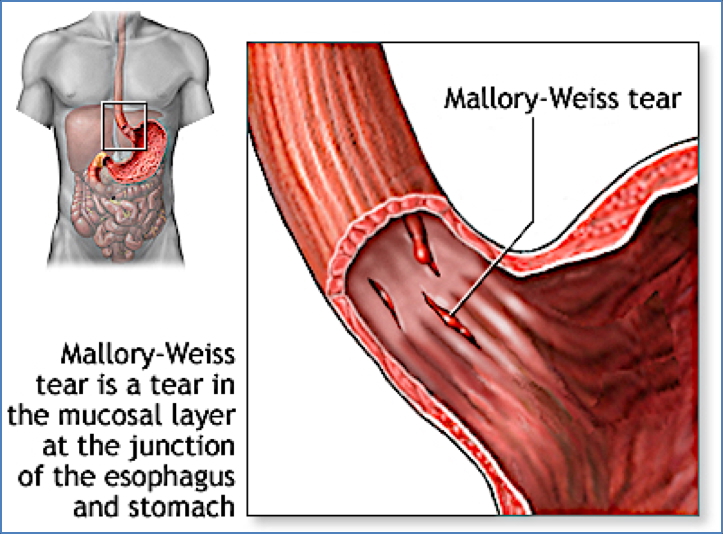Table of Contents
Overview – Mallory Weiss Tear
A Mallory Weiss tear is a longitudinal mucosal laceration at the gastro-oesophageal junction, typically resulting from a sudden rise in intra-abdominal pressure. It is a common cause of minor upper GI bleeding, particularly following forceful vomiting or retching. While often self-limiting, it is important for final-year medical students to recognize its clinical presentation, differentiate it from more serious oesophageal pathologies, and understand when further intervention is needed.
Definition
A Mallory Weiss tear refers to a non-transmural mucosal laceration at the junction of the oesophagus and stomach, resulting in upper gastrointestinal bleeding.
Aetiology
- Sudden increase in intra-abdominal pressure:
- Forceful vomiting (most common cause)
- Chronic coughing
- Straining
- Overeating (notably in specific populations – e.g. Boerhaave syndrome distinction in Pacific Islanders)
- Hiatus hernia – present in ~75% of cases
Pathophysiology
- Acute rise in intra-abdominal pressure leads to forceful retrograde pressure against the lower oesophageal sphincter
- This results in a mucosal tear at the gastro-oesophageal junction
- Unlike Boerhaave syndrome, Mallory Weiss tears are limited to the mucosa and not full-thickness
Morphology
- Linear mucosal tear located at the gastro-oesophageal junction
- Typically confined to the oesophageal mucosa without perforation

Clinical Features
- Haematemesis – usually minor but may appear alarming
- Dysphagia
- Retrosternal pain – particularly post-emesis
Investigations
- Upper GI Endoscopy – confirms diagnosis and rules out other causes of haematemesis (e.g. varices, peptic ulcer disease)
Management
- Supportive management is usually sufficient:
- IV fluids if necessary
- Proton pump inhibitors (PPIs) may be used for mucosal protection
- Endoscopic intervention only if active bleeding persists
- Surgical repair is rarely required
Complications
- Typically causes only minor upper GI bleeding
- Rarely progresses to significant haemorrhage or requires intervention
- Important to differentiate from Boerhaave syndrome (full-thickness rupture)
Summary – Mallory Weiss Tear
A Mallory Weiss tear is a mucosal laceration at the gastro-oesophageal junction, most often triggered by forceful vomiting. It presents with haematemesis and is generally self-limiting. Diagnosis is confirmed by endoscopy, with most cases requiring only supportive treatment. For a broader review of GI bleeding conditions, see our Gastrointestinal Overview page.